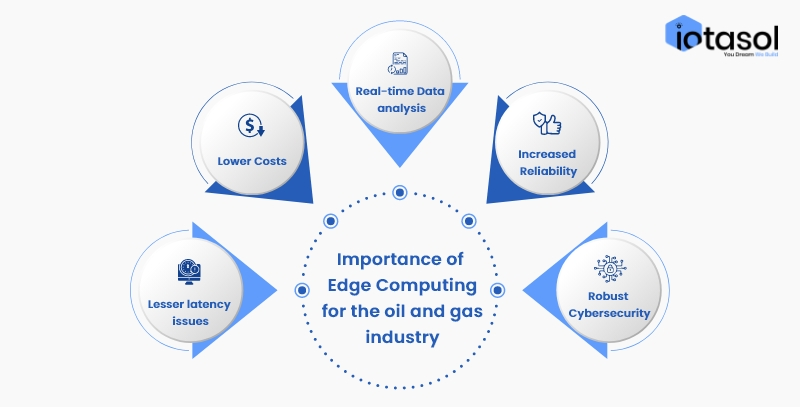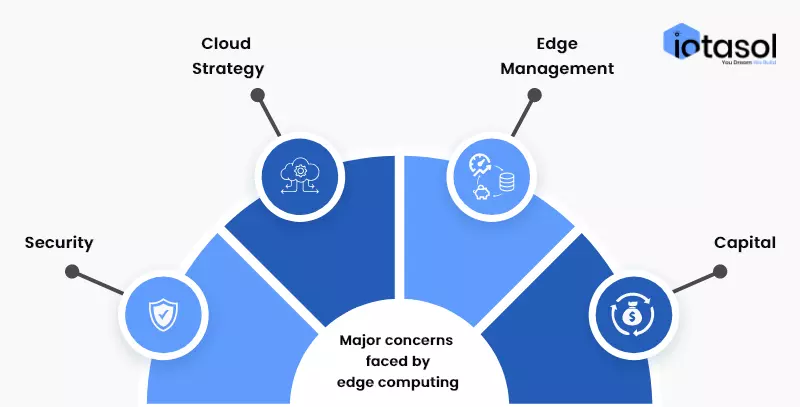Industry: Oil and Gas
6 Min Read
Introduction
The digital revolution is revolutionizing all business realms.
The oil and gas industry makes a great candidate to adopt digital
solutions like edge computing, IoT, AR/VR, etc. to meet goals such
as operational efficiency and price reduction.
This industry goes through a humongous amount of data generation daily.
How this data is collected, consolidated, and analyzed plays a
significant role in defining the overall effectiveness of operations
as well as the cost incurred.
This blog reflects on the concept of edge computing and how it can be
a breakthrough solution for the oil and gas industry leading to improved
sustainability and cost-effective business processes.
1. What is Edge Computing?
Edge Computing refers to a new-age computing paradigm where a range
of networks and devices is located near the user.
Edge is about processing the data at a place where
it is generated rather than sending it over to some
other place and then getting the results.
This helps in quicker data processing and
enables faster action on results produced.
2. Importance of Edge Computing for the oil and gas industry
Considering the highly competitive nature of the oil and gas industry as well as the unpredictable rise in demand now and then, Digital transformation has become significant in this sector.
The oil and gas industry needs to leverage latest digital technology trends like IoT, AR/VR, edge computing, etc. to open the doors to greater productivity and overall success.
Let’s understand some key processes that edge computing can contribute to in the oil and gas industry.
a. Real-time Data analysis
It is quite tragic that while a huge amount of data is produced in
the oil and gas industry daily, a very little fraction of this data
is used to get useful insights while the rest of it goes unprocessed.
For specification, a single oil rig produces around a terabyte of data
every day.
Also, whatever data is analyzed, has to be sent to a remote server
where the application is hosted rather than getting real-time
data analysis for spontaneous action. The irony is that a single day’s
data can take around 12 days to get transferred for analysis.
By the time this analysis is completed, the data no longer
remain relevant.
The solution lies in Edge Computing. It helps in the real-time
analysis of the huge amount of data produced in the supply chain
throughout. This solution is valid in varied environments
be it remotely located oil rigs, wellbores situated very
deep underground or Intense Liquified Natural Gas environments.
Here are the benefits that the oil and gas industry
is bound to experience with the incorporation of
Edge Computing solutions.
b. Lower Costs
A networking equipment’s bandwidth decides the speed at which data is transferred. Data transfer costs a lot when a large amount of data has to be uploaded to and downloaded from the cloud. Since edge computing allows the processing of data locally, most of this expenditure can be avoided.
c. Lesser Latency Issues
Latency refers to the time taken for the data from the moment
it is transferred to the moment it reached its destination
and comes back in the round trip. In case of excessive latency,
a traffic jam kind of situation occurs. However, edge computing,
with its more distributed network, offers real-time responsiveness
and removes the entire round-trip journey chaos
of transferring and receiving the data.
This way data processing becomes possible near end-user applications like mobile phones, tablets, security systems, etc.
Reduction in latency leads to quick and automated decision-making.
d. Increased Reliability
Edge computing ensures increased reliability because of processing
data closer to the edge and making security threats and network
outages more unlikely. Even without a good internet connection,
data can be processed with little to no hindrances. Also, failure
at one edge device does not hinder the operations of other edge
devices thus ensuring reliability in the entire system.
e. Robust Cybersecurity
Segmenting an edge network is very easy when it comes
to security purposes. It is very important to protect
network layers because it is the place where all the
communication of turning data into information happens
to facilitate right and quick decisions. The edge
architecture allows cybersecurity so that the data
collected remains safe from unauthorized third-party
sources.
Looking for edge smart solutions? Contact iotasol to know our offerings
3. Major concerns faced by Edge computing
Edge computing has some challenges and concerns in the oil and Gas industry sector.
Let's have a clear understanding of these challenges.
a. Security
Since edge devices are deployed far outside the data center, security remains a major concern. There is a lack of firm physical security for the data gathered at the edge. Crucial information can be compromised easily
with the removal of a disk drive from the edge resource.
Also, with companies deploying more and more edge devices to manage
a wide range of operations, tracking and monitoring all these devices
becomes difficult. Over time, issues like bandwidth overcrowding can
lead to endangered security for multiple devices.
b. Cloud Strategy
If we look at the simplest structure of edge computing,
it is a single-edge computer functioning quietly.
But this edge computer has to be updated rather
frequently to avoid security breaches. And a cloud
connection is required for that.
So, a cloud strategy becomes essential for the smooth
functioning of edge computers. Not to forget, that while
an edge computer certainly adds value, combining data
from multiple edge computers and analyzing it is what
makes the whole process significant.
So, building a cloud strategy and deciding on factors like which cloud to use and how
to analyze data using the cloud is a key element in defining edge computing as a success.
c. Edge Management
Proper management services are required to proliferate edge devices. These management services
will need to take care of various functions like calibrating devices, executing repairs,
assisting installations, etc. while the edge devices are monitoring the process. The
important question is to decide what protocols and practices will govern these services.
Also, there needs to be an emerging service industry to facilitate such support.
d. Capital
The oil and Gas industry is lacking in the required capital to invest in edge computing
even if it offers perks like greater production, lesser cost, and streamlined operations.
The way out can be the incorporation of capital-light business models such that a third party
can take care of the capital part in the exchange for some perks.
Conclusion
The whole discussion around using edge computing in the oil and gas industry makes a very
strong case because the power of automation when leveraged at the edge or operating front
of the oil and gas business can lead to lower costs, and better productivity.


